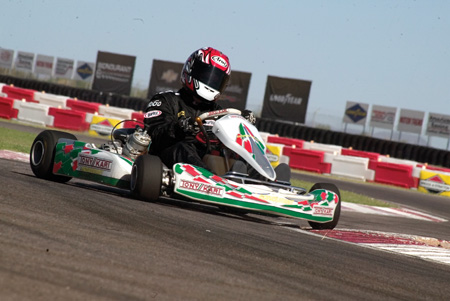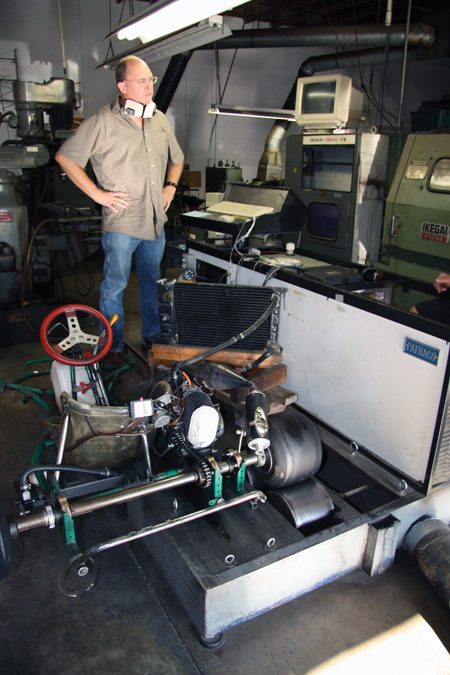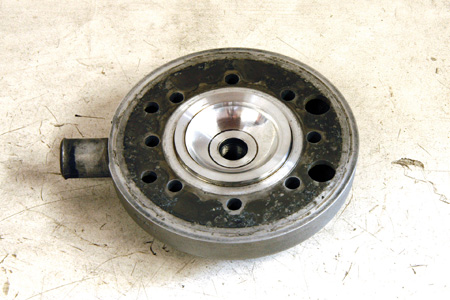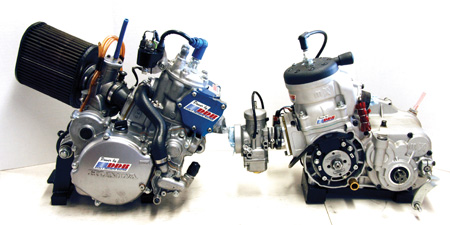Like many forms of racing in this economy, shifter kart racing is in a state of change. With substantially more power, a six-speed sequential gearbox and 4-wheel brakes, they certainly delivered "bang for your buck" performance. Probably the biggest testament to the value of racing shifter karts is the career path of Scott Speed who went virtually from shifter kart champion to a ride in F1.
Initially the engine of choice in the U.S. was a 125cc motocross engine with Honda being the predominant brand. After a few years of “Moto” engines the dedicated Italian 125cc kart shifter motors migrated here from European Formula C shifter racing. They became known as ICC engines with brands like TM, Pavesi, Vortex, Maxter and many others. They were nearly race-ready out of the box and they thrived with broad, high rpm power curves. For the last few years these dedicated ICC kart motors have become the backbone of the Pro classes in shifter kart racing.
However, what started out as affordable, entry-level racing soon escalated to a point where fewer and fewer people could afford the top-notch equipment needed to be competitive. A national-level fully prepared ICC engine will cost a racer about $7,000, and if you plan on getting serious about your racing, you’re going to need a spare backup engine too.
A fully modified Moto engine costs about the same amount of money and produces equivalent power to an ICC, however they have much different torque curves. Open Moto engines have fallen out of favor with pro racers because the brutal low and mid-range torque of these engines negatively affect the handling of today’s “softer” shifter kart chassis that are developed mostly in Europe for ICC style engines.
Of that $7,000 engine cost approximately $5,000 is spent on the initial ICC engine purchase leaving about $2,000 for the engine builder. Let’s see…$2,000 to build a one-cylinder engine that you can hold in your hands – it sounds pretty attractive but read on before you sell your CK 10.
As shifter karts grew in popularity with Hollywood stars and NASCAR heros like Ricky Rudd going public about how great they are, many people with no karting or racing experience went out and purchased a shifter kart from a local shop, and took it out once only to realize how far over their heads they were. They immediately put their shifters up for sale and moved on to some form of entertainment a little mellower.
Kart shops now have a much better alternative for the newbies. They are called TAG (touch and go) karts and although they still have 125cc water cooled two-stroke engines, they are fitted with an electric starter and centrifugal clutch instead of a gearbox, and are much more friendly to drive although still extremely fast.
Many of these factors plus the downturn in the economy has spawned the Spec Honda classes that make up the bulk of shifter kart racing today. Spec Honda uses a CR125 Honda engine with few allowable modifications. Yet the racing is fierce, and you need a professionally prepared engine to be competitive. Spec Hondas are more cost effective for the racer for both the initial purchase and the race-to-race cost of maintenance. All successful Honda 125 kart engines begin life as engine kits from Honda.
For approximately $2600 you get a box full of individually packaged engine and transmission components that must be put together into a running assembly. There are basically two model years only that are used, the ’99 cylinder and head assembly and the ’01 cylinder and head assembly. Most of the other parts in the engine kit are interchangeable, but if you are planning on buying an old CR 125 motocross bike and using the engine, it had better be a ’99 or ’01 or you’re just spinning your wheels.
To take a closer look at today’s shifter kart engine technology we visited Darcy DeCoste’s engine shop that is dedicated to shifter kart engines and GP motorcycle two-strokes. Darcy’s shop is located in Santa Paula, California a little northwest of LA. From this location Darcy and his brother Vernon have turned out championship winning shifter kart motors of all kinds for years. Racers like Phil Carlson, Matt Jaskol, Jason Bowles, Brendon and Ryan Phinny and Conner DePhilippe are just a few riding DDR power to victory.
We first wanted to get a grip on all of the power numbers being thrown around the pits to see what engine builders should be shooting for. Darcy has a water brake chassis dyno that once belonged to Yamaha. He likes it because he can do steady state testing, and he can also run the kart through the gears and check the clutch. He claims that his water brake is 10-16% more conservative than most DynoJets, and the power numbers he shoots for with a fully prepped ICC or “open” moto engine is in the 43-44 hp range. Darcy said that both styles of engines make about the same peak power.
The difference is that the moto motor does it with cylinder pressure (hence the massive low and mid-range torque), and the ICC motor does it with rpm. Of course with rpm comes cost – a competitive pro racer will require that the $400 connecting rod in his ICC engine be replaced every one or two races. On the other hand a good competitive Spec Honda will show 35-37 hp on Darcy’s dyno and the bottom end is good for quite a few race weekends.
Let’s look at shifter kart engines from an engine builder’s perspective. First, it should tell you something that there are only a handful of national event winning caliber builders in the nation. I believe the reason for this is that it takes a lot of specialized knowledge to be competitive here. Knowledge gained only through years of experience and testing. Sure, just about anyone can assemble a Honda engine kit and make it run – that’s not the level of sophistication we are talking about here.
Darcy pointed out that you could take an engine from any of the top shops, and if you don’t know how to jet the carburetor and gear it, you will most likely be back in the middle of the pack somewhere. So for these reasons, the importance of tuning and track setup cannot be underestimated in shifter kart racing today.
For years the traditional ways you increased the power of a two-stroke engine was to raise the compression, modify the squish band in the cylinder head, grind out the transfer and exhaust ports in the cylinder, tweak the ignition timing and modify the reeds and reed cage (in reed-type engines). To some degree you still do these same mods, but with ICC motors to a much smaller degree.
Darcy says that they change port widths, heights and angles and reshape the porting in the crankcase, but in some cases the ports are just changed .005?. A slip of the grinder can literally kill a cylinder from being competitive. The ICC cylinder heads are pretty good the way they come, but Darcy will machine them to change compression depending upon the driver and track.
Open class Moto motors are different animals. They require extensive cylinder head machining, inlet track port work including splitters and stuffers to increase port velocity. Reed tension and cage design is extremely important and whereas ICC motors are limited to fixed (locked) ignition timing, there are programmable ignition systems for the Moto engines that make a huge difference in performance.
The bulk of Darcy’s work these days is spec Hondas that go out the door for $4,800 for a national level engine and $4,300 for a club-level piece. With the rules being so restrictive to internal engine modifications it’s a wonder that he can increase performance as much as he does. There are a couple of open areas in the rules that Darcy exploits to good advantage.
The rules allow you to remove and plug the power valve (a variable sized exhaust port that broadens the throttle response for trail riding motorcycles). The size and shape of these plugs have a large affect on power output. Another area where Darcy’s expertise pays off is with reed cages and reeds. The rules state that the reed cages must be stock although different year cages can be used. And reeds are totally non-tech items and Darcy has his own reeds manufactured and juggles various reed cages to suite track conditions and driver preferences.
Engine assembly is pretty straight forward only extremely precise. The crankshaft assembly is trued to within .0003?. The crankshaft seals are pressed into the cases perfectly straight because crankcase compression is what determines how much power the engine will produce. There is an allowable ignition modification in the rules that Darcy also makes. The remainder of the spec Honda mods are external with one of Darcy’s jetting kits and attention to detail like the silencers that go onto the spec pipe. After years of testing Darcy recommends and uses the M4 silencer.
To be in the shifter kart engine building business doesn’t require much specialized equipment from what a normal engine shop would have except for a small variable angle grinder that can get into tight places for porting cylinders and cases. Good measuring equipment and a surface plate are must have items, as are some fixtures for assembling crankshafts. However, the key piece of equipment is a quality kart engine dyno. The only way you will ever know what is good and what is bad is to test. Then back your dyno testing up with track testing. When you start to see a correlation between the two, you will be on your way to building the knowledge base necessary to be competitive in the world of shifter kart racing.
Source:
Darcy DeCoste Racing
333 S. 11th St.
Santa Paula, CA 93060
Phone: 805-933-2616
Len Emanuelson has spent the past 37 years reporting on the performance and racing market. He enjoys racing his shifter kart whenever he gets the chance.

















